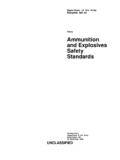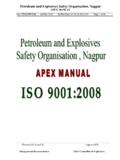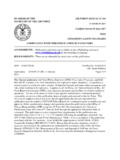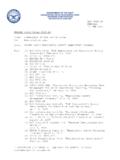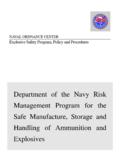Transcription of The U.S. Army Materiel Command Safety Reshape and the ...
1 The Army Materiel Command Safety Reshape and the ammunition and explosives Safety policy action Committee (AMMOPAC)byEric T. OlsonSafety EngineerSafety OfficeHeadquarters, Army Materiel CommandCHART 1 -- TitleReport Documentation PageForm ApprovedOMB No. 0704-0188 Public reporting burden for the collection of information is estimated to average 1 hour per response, including the time for reviewing instructions, searching existing data sources, gathering andmaintaining the data needed, and completing and reviewing the collection of information. Send comments regarding this burden estimate or any other aspect of this collection of information,including suggestions for reducing this burden, to Washington Headquarters Services, Directorate for Information Operations and Reports, 1215 Jefferson Davis Highway, Suite 1204, ArlingtonVA 22202-4302.
2 Respondents should be aware that notwithstanding any other provision of law, no person shall be subject to a penalty for failing to comply with a collection of information if itdoes not display a currently valid OMB control number. 1. REPORT DATE 17 AUG 1994 2. REPORT TYPE 3. DATES COVERED 00-00-1994 to 00-00-1994 4. TITLE AND SUBTITLE Headquarters, Army Materiel Command Safety Reshape and The AMMOPAC 5a. CONTRACT NUMBER 5b. GRANT NUMBER 5c. PROGRAM ELEMENT NUMBER 6. AUTHOR(S) 5d. PROJECT NUMBER 5e. TASK NUMBER 5f. WORK UNIT NUMBER 7. PERFORMING ORGANIZATION NAME(S) AND ADDRESS(ES) Headquarters, Army Materiel Command , Safety Office,5001 Eisenhower Avenue,Alexandria,VA,22304 8. PERFORMING ORGANIZATIONREPORT NUMBER 9. SPONSORING/MONITORING AGENCY NAME(S) AND ADDRESS(ES) 10. SPONSOR/MONITOR S ACRONYM(S) 11.
3 SPONSOR/MONITOR S REPORT NUMBER(S) 12. DISTRIBUTION/AVAILABILITY STATEMENT Approved for public release; distribution unlimited 13. SUPPLEMENTARY NOTES See also ADM000767. Proceedings of the Twenty-Sixth DoD explosives Safety Seminar Held in Miami, FLon 16-18 August 1994. 14. ABSTRACT 15. SUBJECT TERMS 16. SECURITY CLASSIFICATION OF: 17. LIMITATION OF ABSTRACT Same asReport (SAR) 18. NUMBEROF PAGES 14 19a. NAME OFRESPONSIBLE PERSON a. REPORT unclassified b. ABSTRACT unclassified c. THIS PAGE unclassified Standard Form 298 (Rev. 8-98) Prescribed by ANSI Std Z39-18 This paper is a progress report and a success story. It summarizes substantial changes thathave been implemented within the Army Materiel Command (AMC) Safety programduring the last year. These changes were necessitated by organizational consolidations,realignments, and closures connected with the downsizing of AMC since 1989.
4 CHART 2 -- AMC The Army Materiel Command (AMC) is the principal Materiel development, acquisition,and logistics organization of the Army, and serves the military services as the singlemanager for conventional ammunition . Today AMC employs just over 80,000 people. Over90 percent of the work force consists of career civilian employees assigned to about 350locations distributed among 40 states and 13 countries. AMC has 10 major subordinatecommands (MSCs). Several MSCs manage the acquisition and logistics of their respectivecommodity groups, such as ammunition , missiles, tank and automotive Materiel , orcommunications and electronic equipment. Other MSCs have missions that support the entirespectrum of AMC managed Materiel with specific services such as basic and applied research,test and evaluation, or storage and maintenance.
5 The MSCs direct the activities of numerousammunition plants, arsenals, depots, laboratories, proving grounds, and other installations andactivities, as well as Logistics Assistance Representatives deployed with Army field units. The MSCs also contract extensively with private industry, not only to purchase Armymateriel, but for significant mission services ranging from research to demilitarization anddisposal of equipment and materials, including ammunition . This broad and complex missionis reflected by the three Core Competencies maintained by AMC: Acquisition Excellence,Logistics Power Projection, and Technology Generation and Application. CHART 3 -- SafetyAMC has, for decades, maintained a comprehensive, leading edge Safety program. Theprogram is all encompassing in that it is infused into every aspect of AMC's mission.
6 Thismeans the program has two thrusts. One is directed inward, and addresses protection ofAMC's operations, facilities, and work force. The other looks outward, and addressesprotection of soldiers, their equipment, and their mission. While no part of AMC's mission isbeyond the scope of the Safety program, several elements of the program have receivedemphasis and a large share of Safety resources. These are Safety program areas that areassociated with high potential risks or liabilities, that have a high degree of public interest, orthat have high visibility for other reasons. The need to thoroughly and aggressively managethose areas has not diminished in importance with downsizing the military in the post-coldwar era. In fact, the social and political climate surrounding issues regarding hazardousmaterials and operations has never required a greater priority on protecting people and factor effects the need for vigilance in the ammunition and explosives Safety arena.
7 Although AMC has been decreasing in size, its ammunition stockpile has grown considerablybecause of returns from Europe and Southwest Asia and because AMC has received title towar reserve stocks worldwide. Perhaps more importantly, the ammunition demilitarizationstockpile today consists of more than 400,000 short tons compared to less than 200,000 shorttons in 1989. CHART 4 -- StaffAMC today is different in size and organization from the AMC of five years ago. At that timeAMC employed over 100,000 civilian and 10,000 military personnel, and had a somewhatmore extensive level of industrial activity. There were 49 people devoted to administrativeand technical functions of the AMC Safety program at the Headquarters, AMC level -- 15 inthe headquarters Safety Office and 34 at the AMC Field Safety Activity (FSA) inCharlestown, Indiana.
8 As AMC downsized by a little over 25 percent, the number of work-years devoted to Safety has decreased more dramatically. In 1990, a reduction of the AMCheadquarters (including FSA) decreased the Safety staff by 37 percent. In 1992, the FieldSafety Activity was closed. Some of its functions survived (16 work-years) which weretransferred to other organizations (6 work-years to the AMC Safety Office, and 10 work-yearsto non-AMC activities). Five of the six spaces that transferred to HQ AMC were eliminatedand one additional space in the AMC Safety Office was eliminated shortly thereafter. Theresult is that today the Safety staff at the HQ AMC level is 83 percent below that in 1989. More than 3 of the work-years that transferred from FSA to HQ AMC were for explosivessafety 5 -- ExfctnsThe increase in mission and reduction of personnel resources necessitated the redistribution ofduties among the remaining Safety Office personnel.
9 As a result, work years within theSafety Office remained available for explosives Safety functions to which approximately 4work years had been devoted. These functions remain essential to managing a comprehensivesafety program. They include: Maintaining AMC explosives Safety policy and regulations. Performing explosives Safety program evaluations of AMC elements. Evaluating and preparing responses to requests for explosives Safety waivers and exemptions. Tracking corrective actions in response to findings in Board of Investigation reports of explosives accidents, and publishing lessons learned. Evaluating and responding to requests for mixed compatibility ("Category Z") storage of ammunition and explosives . Developing procedures and methodology for determining surface and airspace danger zone dimensions, and approving proposed surface danger zones for specific weapon/ ammunition configurations.
10 Serving as the HQ AMC voting member of the Army Fuze Safety Review Board. Managing the AMC Safety and Occupational Health Management Career Program as related to developing AMC Safety engineers and specialists qualified in ammunition and explosives Safety , and monitoring the need for and availability/adequacy of explosives Safety training for the AMC work force. Monitoring the AMC explosives facility site plan and final Safety submission process. Tracking and reporting AMC actions in response to explosives Safety related findings by external survey and inspection agencies. CHART 6 -- NewmgtThe personnel resources available within the AMC Safety Office were not sufficient to fullyaccomplish those explosives Safety functions. The other AMC Safety program areas weresimilarly effected by the severely reduced staffing level.











